Utahraptor ostrommaysorum Kirkland, Gaston & Burge, 1993

Phylum: Chordata Haeckel, 1874
Subphylum: Vertebrata Cuvier, 1812
Classe: Dinosauria Owen, 1841
Ordine: Saurischia Seeley, 1887
Famiglia: Dromaeosauridae Matthew & Brown, 1922
Genere: Utahraptor Kirkland, Gaston, Burge, 1993
Descrizione
Questo dinosauro è il più grande membro finora conosciuto della famiglia dei dromeosauridi, che include altri dinosauri famosi quali Deinonychus e Velociraptor. I resti dell'Utahraptor, provenienti dal Barremiano della formazione di Cedar Mountain, furono descritti nel 1993 da Gaston, Kirkland e Burge. Casualmente, poco tempo prima Steven Spielberg produsse Jurassic Park, nel quale uno dei dinosauri principali, pur venendo nominato come Velociraptor, era straordinariamente simile alla nuova specie scoperta e a Deinonychus. La specie tipo di questo animale, U. ostrommaysorum, è stata chiamata così in onore del paleontologo americano John Ostrom e di Chris Mays, della Dinamation International. Come tutti i dromeosauridi, Utahraptor possedeva un gigantesco artiglio sul secondo dito del piede, che nel suo caso poteva raggiugere i 23 centimetri di lunghezza. L'animale probabilmente afferrava le sue prede con gli arti anteriori e le colpiva con quelli posteriori. Recenti test adottati su artigli simili, ma più piccoli, di Velociraptor, indicano che questo tipo di artigli probabilmente era usato per pugnalare, piuttosto che per squarciare. Lungo fino a sei metri e pesante circa 700 chilogrammi, l’Utahraptor era sicuramente un predatore eccellente. Si pensa che mute di questi animali avrebbero potuto cacciare e abbattere addirittura i grandi sauropodi come i Cedarosaurus o addirittura i "carri armati viventi" come i Gastonia, anche se è forse impossibile sapere se effettivamente Utahraptor vivesse in branchi. Si pensa che Utahraptor fosse strettamente imparentato con i dromeosauri primitivi come Adasaurus, e con il grande Achillobator, piuttosto che con i più famosi Deinonychus e Velociraptor.
Diffusione
Genere di dinosauri carnivori vissuto nel Cretaceo inferiore nello Utah. Il suo nome vuol dire, appunto, "predatore dello Utah".
Bibliografia
–Kirkland, J. I.; Burge, D.; Gaston, R. (1993). "A large dromaeosaurid (Theropoda) from the Lower Cretaceous of Eastern Utah". Hunteria. 2 (10): 1-16.
–"raptor - ONLINE LATIN DICTIONARY". Online Latin Dictionary.
–Adams, Brooke (June 15, 1993). "Director Loses Utahraptor Name Game". Deseret News.
–Olshevsky, G., 2000, An annotated checklist of dinosaur species by continent. Mesozoic Meanderings 3: 1-157.
–Costa, T. V. V.; David, N. (2019). "Commentaries on different uses of the specific epithet of the large dromaeosaurid Utahraptor Kirkland et al., 1993 (Dinosauria, Theropoda)". The Bulletin of Zoological Nomenclature. 76 (1): 90-96.
–Britt, B. B.; Chure, D. J.; Stadtman, K. L.; Madsen, J. H.; Scheetz, R. D.; Burge, D. L. (2001). "New osteological data and the affinities of Utahraptor from the Cedar Mountain Fm. (Early Cretaceous) of Utah". Journal of Vertebrate Paleontology. 21 (3): 36A.
–Senter, P. (2007). "A method for distinguishing dromaeosaurid manual unguals from pedal "sickle claws"". Bulletin of the Gunma Museum of Natural History (11): 1-6.
–Erickson, G. M.; Rauhut, O. W. M.; Zhou, Z.; Turner, A. H.; Inouye, B. D.; Hu, D.; Norell, M. A. (2009). "Was Dinosaurian Physiology Inherited by Birds? Reconciling Slow Growth in Archaeopteryx". PLOS ONE. 4 (10): e7390.
–Sues, Hans-Dieter; Averianov, Alexander; Britt, Brooks B. (December 22, 2022). "A giant dromaeosaurid theropod from the Upper Cretaceous (Turonian) Bissekty Formation of Uzbekistan and the status of Ulughbegsaurus uzbekistanensis". Geological Magazine. 160 (2): 355-360.
–Chiappe, Luis M. (2007). Glorified Dinosaurs: The Origin and Early Evolution of Birds. Wiley-Liss. p. 32.
–Martin, Damien; Currie, Philip J.; Kundrát, Martin (2023). "Variability of bone microstructure and growth lines in the evolution of troodontids and dromaeosaurids". Acta Zoologica. 105 (2): 135-175.
–Benson, R. B. J.; Hunt, G.; Carrano, M.T.; Campione, N.; Mannion, P. (2018). "Cope's rule and the adaptive landscape of dinosaur body size evolution". Palaeontology. 61 (1): 13-48.
–Benson, Roger B. J.; Campione, Nicolás E.; Carrano, Matthew T.; Mannion, Philip D.; Sullivan, Corwin; Upchurch, Paul; Evans, David C. (May 6, 2014). "Rates of Dinosaur Body Mass Evolution Indicate 170 Million Years of Sustained Ecological Innovation on the Avian Stem Lineage". PLOS Biology. 12 (5): e1001853.
–Turner, A.H.; Pol, D.; Clarke, J.A.; Erickson, G.M.; Norell, M.A. (2007). "A Basal Dromaeosaurid and Size Evolution Preceding Avian Flight" (PDF). Science. 317 (5843): 1378-1381.
–Pintore, R.; Hutchinson, J. R.; Bishop, P. J.; Tsai, H. P.; Houssaye, A. (2024). "The evolution of femoral morphology in giant non-avian theropod dinosaurs". Paleobiology. 50 (2): 308329.
–Xu, X.; Zhou, Z.; Wang, X.; Kuang, X.; Zhang, F.; Du, X. (2003). "Four-winged dinosaurs from China" (PDF). Nature. 421 (6921): 335-340.
–Prum, R.; Brush, A.H. (2002). "The evolutionary origin and diversification of feathers". The Quarterly Review of Biology. 77 (3): 261-295.
–Turner, AH; Makovicky, PJ; Norell, MA (2007). "Feather quill knobs in the dinosaur Velociraptor" (PDF). Science. 317 (5845): 1721.
–DePalma, Robert A.; Burnham, David A.; Martin, Larry D.; Larson, Peter L.; Bakker, Robert T. (October 30, 2015). "The first giant raptor (Theropoda: Dromaeosauridae) from the Hell Creek Formation". Paleontological Contributions.
–Turner, A. H.; Makovicky, P. J.; Norell, M. A. (2012). "A Review of Dromaeosaurid Systematics and Paravian Phylogeny". Bulletin of the American Museum of Natural History. 371 (371): 1-206.
–Cau, Andrea; Beyrand, Vincent; Voeten, Dennis F. A. E.; Fernandez, Vincent; Tafforeau, Paul; Stein, Koen; Barsbold, Rinchen; Tsogtbaatar, Khishigjav; Currie, Philip J.; Godefroit, Pascal (December 6, 2017). "Synchrotron scanning reveals amphibious ecomorphology in a new clade of bird-like dinosaurs". Nature. 552 (7685): 395-399.
–Paul, Gregory S. (2016). The Princeton Field Guide to Dinosaurs (2nd ed.). Princeton, New Jersey: Princeton University Press. p. 151.
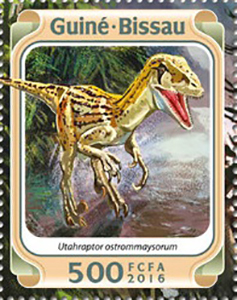
|
Data: 18/01/2016
Emissione: Dinosauri Stato: Guinea-Bissau Nota: Emesso in un foglietto di 6 v. diversi |
|---|
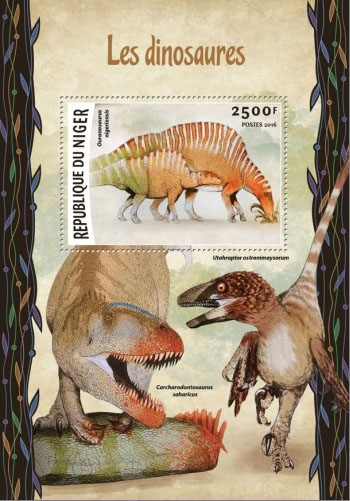
|
Data: 28/05/2016
Emissione: I dinosauri Stato: Niger |
|---|

|
Data: 01/01/2009
Emissione: Animali preistorici Stato: Equatorial Guinea |
|---|
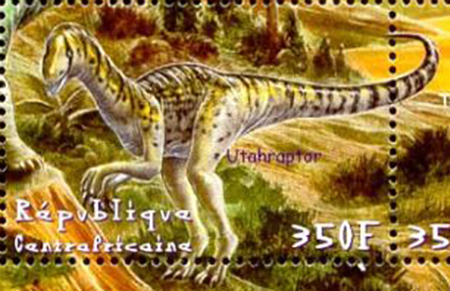
|
Data: 31/07/2001
Emissione: Mostra filatelica internazionale Belgica 01 Brussel Belgio Stato: Central African Republic Nota: Emesso in un foglietto di 6 v. diversi |
|---|
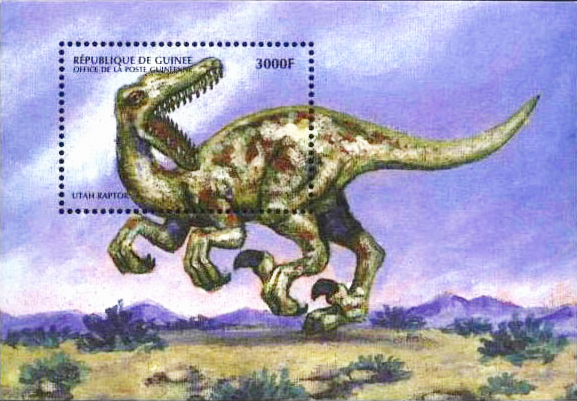
|
Data: 12/08/1999
Emissione: Fauna preistorica Stato: Guinea |
|---|

|
Data: 24/01/2005
Emissione: Animali preistorici Stato: Guyana Nota: Emesso in un foglietto di 4 v. diversi |
|---|
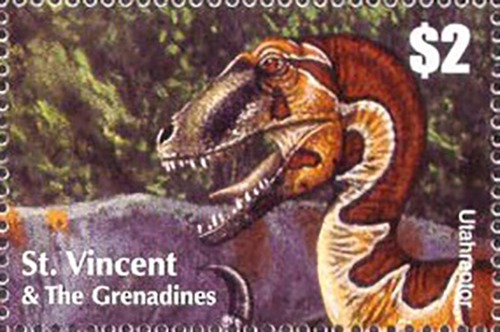
|
Data: 05/11/2003
Emissione: Dinosauri Stato: St. Vincent and the Grenadines |
|---|
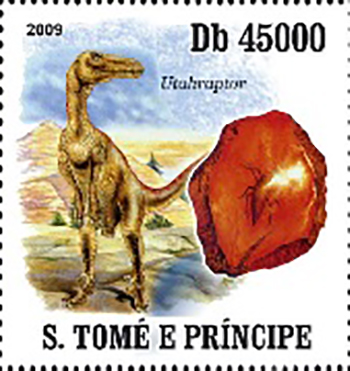
|
Data: 01/07/2009
Emissione: Alfred Russel Wallace (1823-1913) e Charles Darwin (1989-1982) Stato: St. Thomas and Prince Nota: Emesso in un foglietto di 4 v. diversi |
|---|
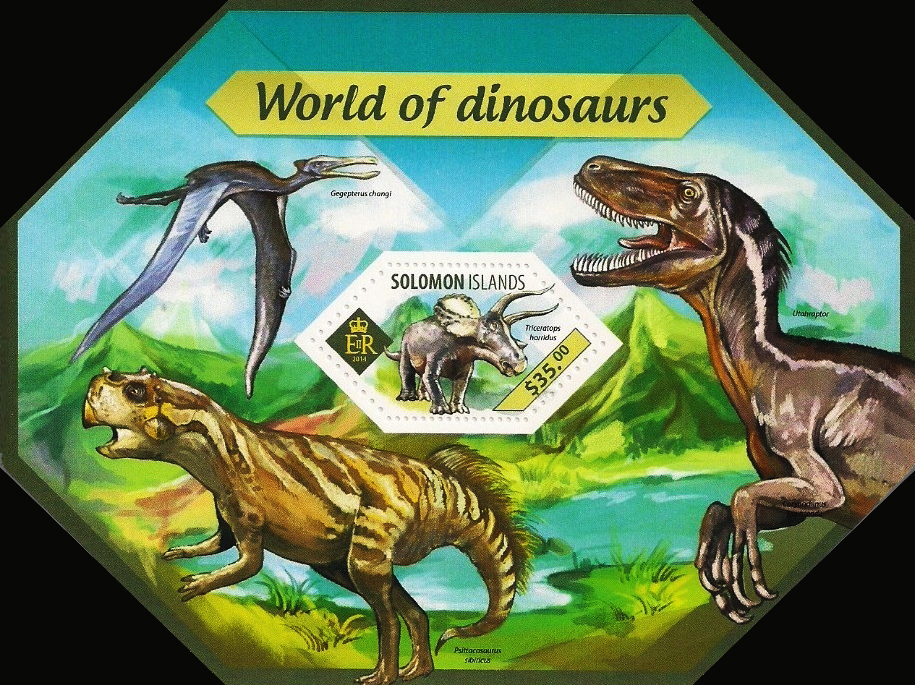
|
Data: 25/08/2014
Emissione: Dinosauri Stato: Solomon Islands Nota: Presente nel foglietto |
|---|
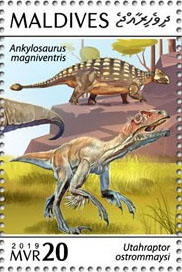
|
Data: 12/02/2020
Emissione: Dinosauri Stato: Maldives Nota: Emesso in un foglietto di 4 v. diversi |
|---|